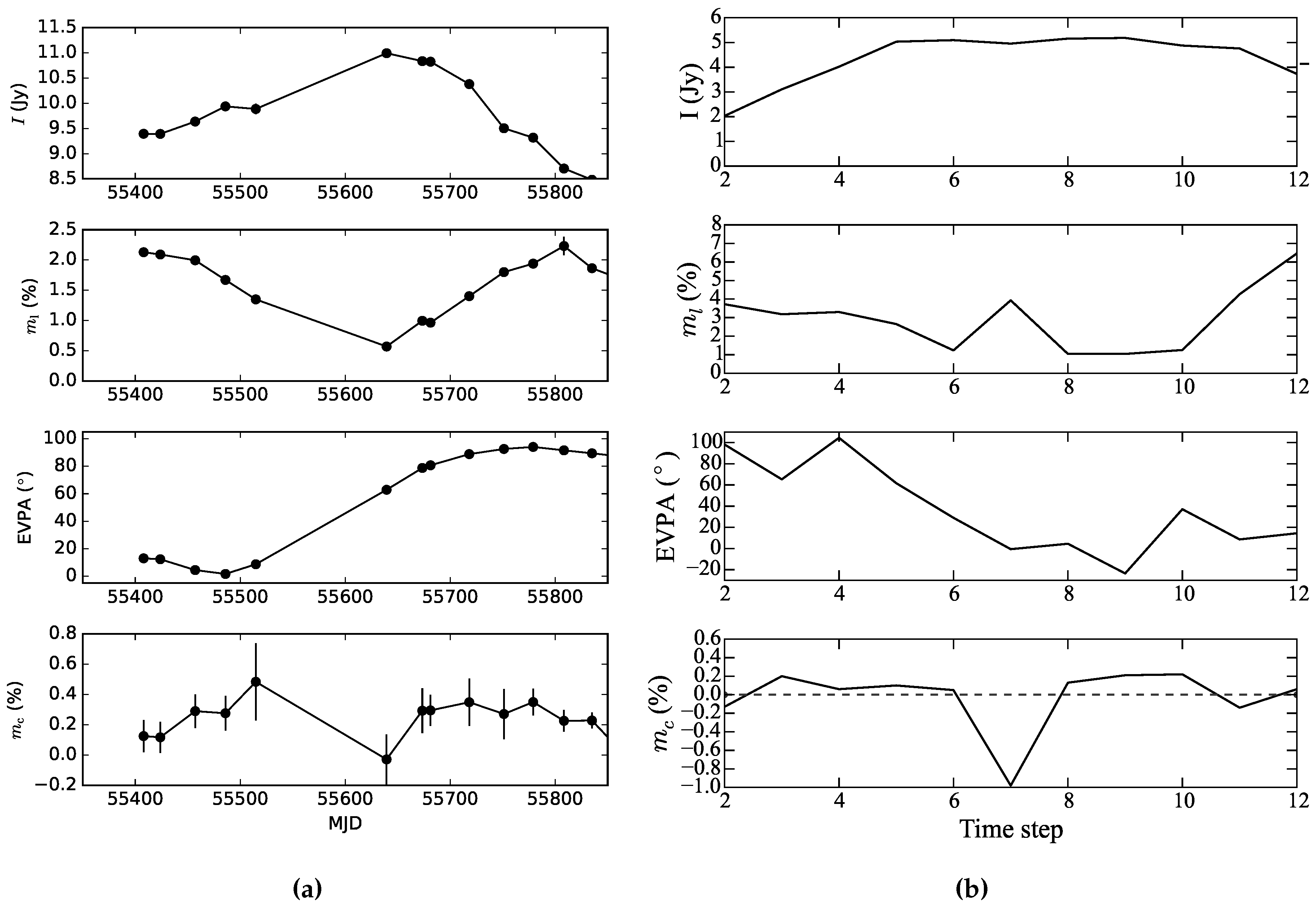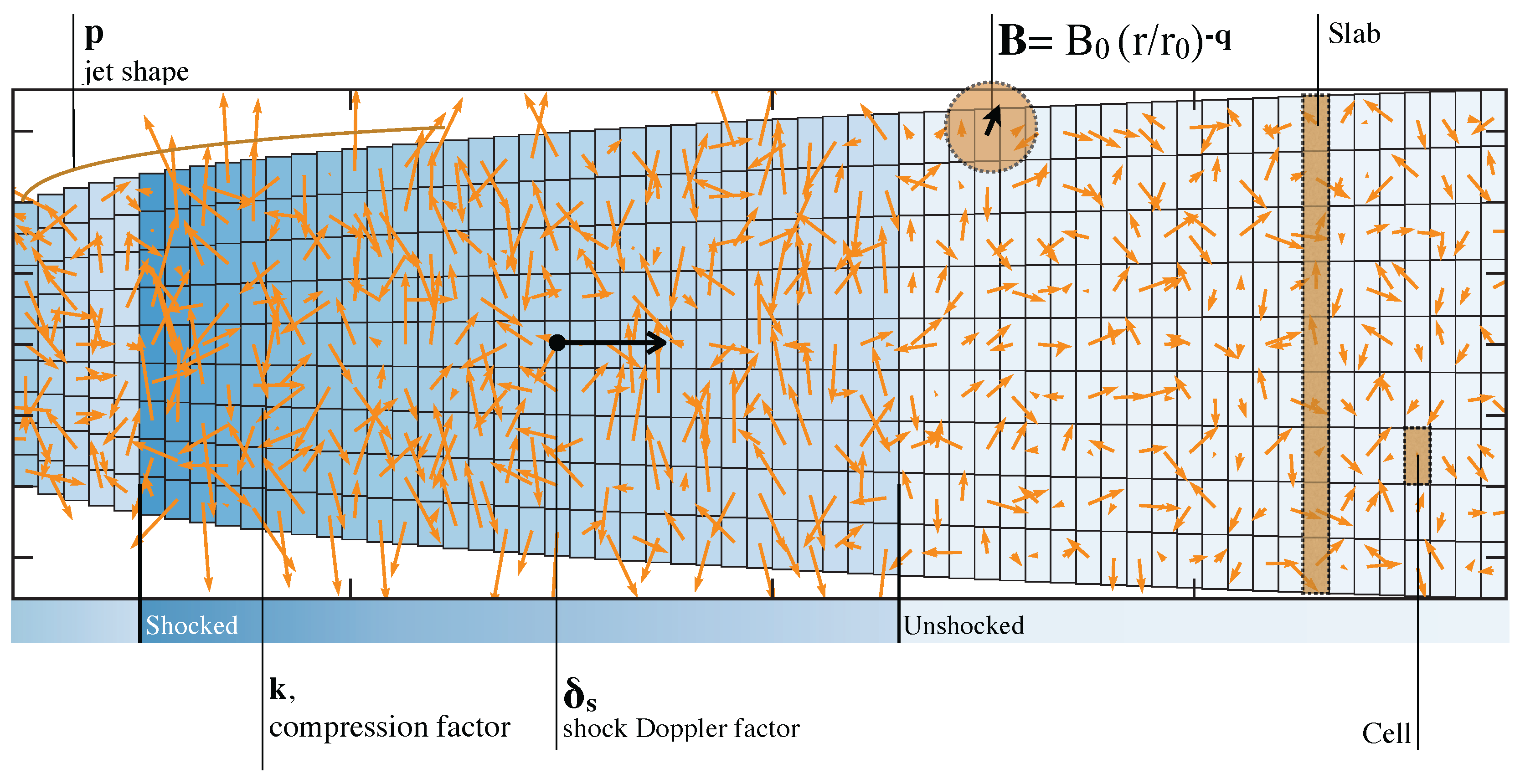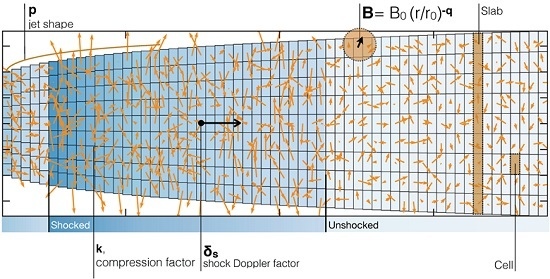Physical Conditions and Variability Processes in AGN Jets through Multi-Frequency Linear and Circular Radio Polarization Monitoring
Abstract
:1. Introduction/Overview
2. High-Precision Linear and Circular Polarimetry with the 100-m Telescope
2.1. Instrumental Linear Polarization Correction
2.2. Optimization of Beam Pattern Fitting Model
2.3. Instrumental Circular Polarization Correction
3. Probing the Physical Conditions in the Jet of 3C 454.3
3.1. Model Overview
3.2. 3C 454.3: A Case Study
3.2.1. Linear and Circular Polarization Variability
- (1)
- A minimization of the linear polarization degree, concurrent with a polarization angle rotation of exactly 90,
- (2)
- a minimization of the circular polarization degree, followed by a change in the circular polarization handedness and
- (3)
- a maximization of the total flux when the peak of the SSA spectrum matches the observing frequency.
3.2.2. Variability Modeling and Constrained Parameters
- the coherence length of the jet’s magnetic field, which is in principle equal to the cell size of our model, to ∼9 pc,
- the jet plasma density to ∼10–100 cm,
- the compression factor of the propagating shock, , and
4. Discussion/Conclusions
Acknowledgments
Author Contributions
Conflicts of Interest
References
- Begelman, M.C.; Blandford, R.D.; Rees, M.J. Theory of extragalactic radio sources. Rev. Modern Phys. 1984, 56, 255–351. [Google Scholar] [CrossRef]
- Marscher, A.P.; Gear, W.K. Models for high-frequency radio outbursts in extragalactic sources, with application to the early 1983 millimeter-to-infrared flare of 3C 273. Astrophys. J. 1985, 298, 114–127. [Google Scholar] [CrossRef]
- Hughes, P.A.; Aller, H.D.; Aller, M.F. Polarized Radio Outbursts in Bl-Lacertae - Part Two - the Flux and Polarization of a Piston-Driven Shock. Astrophys. J. 1985, 298, 301. [Google Scholar] [CrossRef]
- Hughes, P.A.; Aller, H.D.; Aller, M.F. Synchrotron emission from shocked relativistic jets. I - The theory of radio-wavelength variability and its relation to superluminal motion. Astrophys. J. 1989, 341, 54–79. [Google Scholar] [CrossRef]
- Myserlis, I.; Angelakis, E.; Fuhrmann, L.; Pavlidou, V.; Nestoras, I.; Karamanavis, V.; Kraus, A.; Zensus, J.A. Multi-frequency linear and circular radio polarization monitoring of jet emission elements in Fermi blazars. 2014; arXiv:1401.2072. [Google Scholar]
- Klein, U.; Mack, K.H.; Gregorini, L.; Vigotti, M. Multi-frequency study of the B3-VLA sample. III. Polarisation properties. Astron. Astrophys. 2003, 406, 579–592. [Google Scholar] [CrossRef]
- Myserlis, I. A Framework for the Study of Physical Conditions in Astrophysical Plasmas through Radio and Optical Polarization—Application to Extragalactic Jets. Ph.D. Thesis, Max-Planck-Institut für Radioastronomie, Bonn, Germany, 2015. Available online: http://kups.ub.uni-koeln.de/id/eprint/6967 (accessed on 20 October 2016). [Google Scholar]
- Fuhrmann, L.; Angelakis, E.; Zensus, J.A.; Nestoras, I.; Marchili, N.; Pavlidou, V.; Karamanavis, V.; Ungerechts, H.; Krichbaum, T.P.; Larsson, S.; et al. The F-GAMMA program: Multi-frequency study of Active Galactic Nuclei in the Fermi era. Program description and the first 2.5 years of monitoring. arXiv, 2016; arXiv:astro-ph.HE/1608.02580. [Google Scholar]
- Fuhrmann, L.; Zensus, J.A.; Krichbaum, T.P.; Angelakis, E.; Readhead, A.C.S. Simultaneous Radio to (Sub-) mm-Monitoring of Variability and Spectral Shape Evolution of potential GLAST Blazars. AIP Conf. Proc. 2007, 921, 249–251. [Google Scholar]
- Angelakis, E.; Fuhrmann, L.; Nestoras, I.; Zensus, J.A.; Marchili, N.; Pavlidou, V.; Krichbaum, T.P. The F-GAMMA program: multi-wavelength AGN studies in the Fermi-GST era. arXiv, 2010; arXiv:1006.5610. [Google Scholar]
- Pacholczyk, A.G. Radio galaxies: Radiation Transfer, Dynamics, Stability and Evolution of a Synchrotron Plasmon; Pergamon Press: Oxford, UK, 1977; pp. 105–109. [Google Scholar]
- Jones, T.W.; Odell, S.L. Transfer of polarized radiation in self-absorbed synchrotron sources. I. Results for a homogeneous source. Astrophys. J. 1977, 214, 522–539. [Google Scholar] [CrossRef]
- Hovatta, T.; Valtaoja, E.; Tornikoski, M.; Lähteenmäki, A. Doppler factors, Lorentz factors and viewing angles for quasars, BL Lacertae objects and radio galaxies. Astron. Astrophys. 2009, 494, 527–537. [Google Scholar] [CrossRef]
- Sasada, M.; Uemura, M.; Fukazawa, Y.; Yasuda, H.; Itoh, R.; Sakimoto, K.; Ikejiri, Y.; Yoshida, M.; Kawabata, K.S.; Akitaya, H.; et al. Extremely high polarization in the 2010 outburst of blazar 3C 454.3. Astrophys. J. 2014, 784, 141. [Google Scholar] [CrossRef]
- Zhou, Y.; Yan, D.H.; Dai, B.Z. The optical variability properties of flat spectrum radio quasar 3C 454.3. New Astron. 2015, 36, 19–25. [Google Scholar] [CrossRef]


© 2016 by the authors; licensee MDPI, Basel, Switzerland. This article is an open access article distributed under the terms and conditions of the Creative Commons Attribution (CC-BY) license (http://creativecommons.org/licenses/by/4.0/).
Share and Cite
Myserlis, I.; Angelakis, E.; Kraus, A.; Fuhrmann, L.; Karamanavis, V.; Zensus, J.A. Physical Conditions and Variability Processes in AGN Jets through Multi-Frequency Linear and Circular Radio Polarization Monitoring. Galaxies 2016, 4, 58. https://doi.org/10.3390/galaxies4040058
Myserlis I, Angelakis E, Kraus A, Fuhrmann L, Karamanavis V, Zensus JA. Physical Conditions and Variability Processes in AGN Jets through Multi-Frequency Linear and Circular Radio Polarization Monitoring. Galaxies. 2016; 4(4):58. https://doi.org/10.3390/galaxies4040058
Chicago/Turabian StyleMyserlis, Ioannis, Emmanouil Angelakis, Alex Kraus, Lars Fuhrmann, Vassilis Karamanavis, and J. Anton Zensus. 2016. "Physical Conditions and Variability Processes in AGN Jets through Multi-Frequency Linear and Circular Radio Polarization Monitoring" Galaxies 4, no. 4: 58. https://doi.org/10.3390/galaxies4040058






